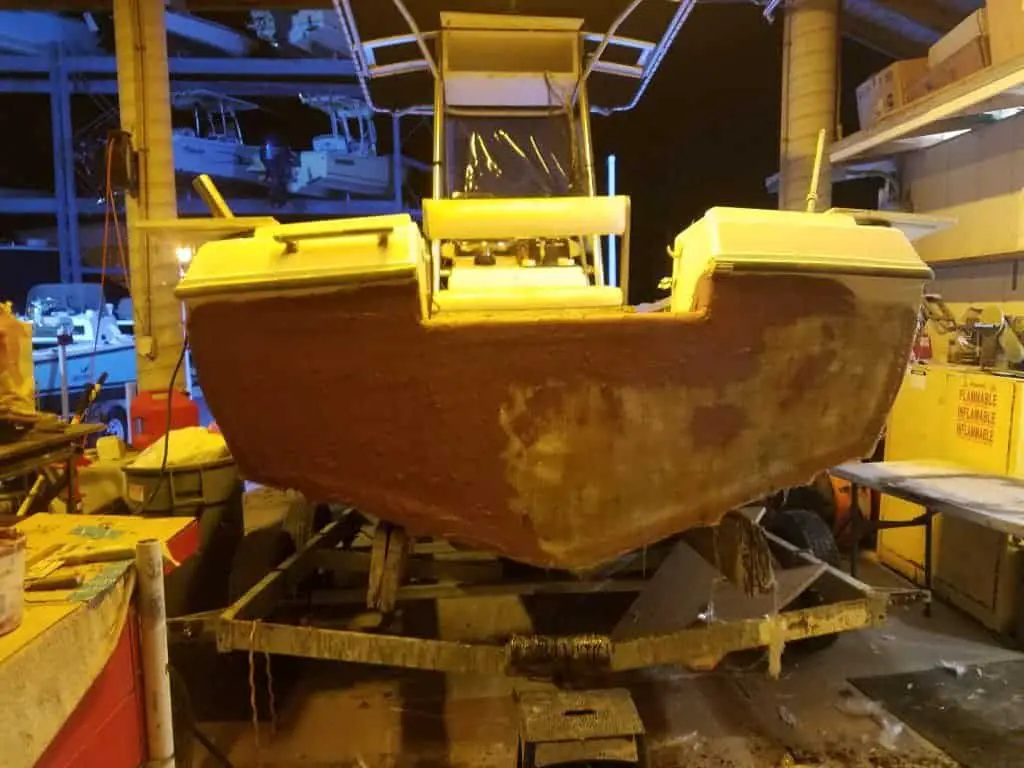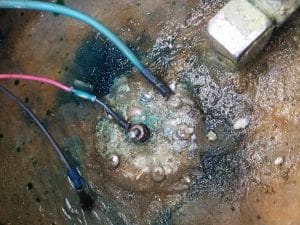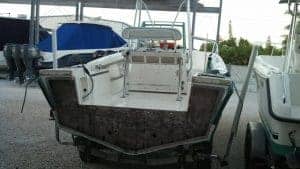There are a couple of major components that need to be specifically looked at on a boat. That is before you purchase a project boat.
What things should you know before buying a project boat? The year, hours, and condition of the engine. The year of the boat. The fuel tank, the hull, the hull’s stringers, and the transom condition.
These are the five major things that you should investigate before purchasing a project boat. Here are a few pointers and things that you want to look at for each one.
The Year, Hours, and Condition of the Engine
The year of the engine is a vital piece of information. You can find the date on the ID tag that is usually placed on the engine bracket for all outboard manufacturers.
(Here is an article that will show you more about finding the engine’s hours.)
As the engines get older, things start to fail. Like this picture on the right. The motor mounts failed on this Optimax and when they did, it bent the entire shift shaft and blew up the gear case.
(Here is another article that will teach you some tips on how to get more hours out of your outboard!)
There are just a few basic checks that you want to perform on an engine before sealing a purchase.
1: You want to make sure the engine has good compression by performing an outboard engine compression test. (Here’s a step-by-step guide!)
For 4-Stroke engines, the compression should be above 160 PSI. Also, you want to make sure there is not more than a 20% difference between the cylinders.
For instance, if one cylinder is at 180 and the next cylinder is at 120, there is a problem and further investigation needs to be done to find out why that is.
Two-Stroke engines should be around 100-130 PSI.
Somewhere in there is good. Again, the same rule applies to the difference between cylinders.
2: Run a spark test to confirm that all of the ignition coils and parts of the ignition system are operating properly.
3: Inspect the fuel system. If the boat has a boat water separator installed, spin it off and pour it out into a clear container. A Gatorade or water bottle is fine. See what kind of condition the fuel is in and if it is all water or anything else suspicious.
4: Slightly crack open the drain seal on the Lower Unit to see the condition of the gear lube. If there is milky gear lube or water. These could be signs of problems. Also, confirm that the engine is shifting properly.
5: Do a good visual inspection of the motor. Looking for broken connectors, cut wires, home electrical connectors, or other modifications that don’t look right.
If there is a major problem with the engine. Performing these tests should reveal any issues that will cost you major bucks when it comes time to putting the boat back in service!
Knowing a little bit about the service records helps too! If the engine hasn’t been serviced in 10 years, other complications might arise. Like not being able to get the lower unit off to change the impeller!
The cost of repowering or finding another engine is a big expense when restoring a project boat. Factor this in before purchasing a project boat.
The Year of the Vessel.
The year of the boat is also very important. You can find the date code on the Hull Identification Number or HIN for short.
This is located on the transom of the boat on the upper starboard side.
Notice on the picture to the left. The last digits are 910. The last two digits are your date code. That means this boat here is a 2010 vessel.
Knowing the manufacturer and year of the boat will give you a good heads up on what possible problems you could incur during your restoration adventure. This leads us to our next major points of what you should know before buying your project boat!
The Fuel Tank
After you know what year the boat was built and what brand it is. This gives you a good starting point for figuring out what the major components that could possibly need to be replaced are. The first one is the fuel tank!
Replacing a fuel tank can get extremely expensive, real quick! If you are looking at a boat and it is a 30-year-old boat, that has never had a fuel tank put in it.
Then that could be a really huge expenditure to think about.
There are a couple of different types of tanks, the most common ones are built-in fiberglass tanks, aluminum tanks, and plastic tanks.
Fiberglass tanks over time begin to delaminate. That means that the layers of the fiberglass inside the tank are starting to separate and come off in chunks.
Getting stuck in the pick up’s and causing serious running issues.
Aluminum tanks over time begin to pit and corrode. Where over years of having water, foam, dirt, and just normal usage.
The aluminum gets little holes in them allowing fuel to leak out into the bilge. Or even cases where the welds begin to fail and also leak fuel out into the bilge.
Plastic tanks begin to swell, bend, and become brittle. The big issues is where the areas around the pick up tubes, the fuel senders, vents, or fuel fills begin to fail. The fuel sender fails and changing it becomes a chore that in some cases is not a possibility.
In almost all of these cases depending on the build of the boat. The floor has to be removed and then the tank has to be dug out and replaced.
In extreme cases, the floor has to be cut out and the console has to be removed. This means de-rigging the entire helm and taking everything out to pull the tank out of the boat.
A classic case of this is Parker boats. The thing about Parker’s is that around 20 years, the tank needs replaced. The problem is, the floor has to be measured and cut out, then refiberglassed back into place. This is extremely costly and time consuming.
Make sure you investigate the fuel tank situation before buying your project boat. (Here is an article that shows you how you can pressure test the fuel tank to make sure it is good!)
Next Up, the Boat’s Hull
Again going back to the year of the hull. You want to look for delamination. Look for cracks along the hull. Around the keel area.
If you notice large deep cracks, or previous “mickey mouse” patchwork, this could be problematic. Make sure you bring your investigation game up because there could be a major issue lying at the door of that boat.
In order to fix major cracks, delamination, or mickey mouse fiberglass repairs, there are long days of sanding and laying glass.
In certain cases though, it could mean such repairs that will affect how the hull will perform in the water. Unless you are extremely good with glasswork. I would stray far away from a hull that has major fiberglass damage to it.
The Stringers Inside the Boat
The stringers are the main strength and structure point to the hull of a boat. They run from the transom to the front of the boat under the deck.
Older boats that have a lot of wood in them, tend to have problems with the stringers over time.
If a stringer fails on a boat, then there can be major catastrophic damages and liabilities that could happen.
A stringer that rots out, or separates from the transom, can turn into a huge issue. You want to get into the bilge and take a hammer or something hard that you can knock on the stringer with.
You are looking and listening for a hollow sound. If the stringers are hallow and echoey, then they are beginning to rot or are already rotten.
With this issue, you are looking at cutting the deck out. Pulling it out and cutting the stringers out, then fiberglassing new stringers in.
This can get complicated and if not done properly you can alter the shape of the hull and also the way it rides and performs. This is another very expensive and time consuming issue that you want to avoid when buying a project boat.
The Dreadful Transom!
The dreadful transom. The most common failure that tends to make people run like crazy from a project boat. Transoms made out of wood, again, tend to rot out after 20 to 30 years.
The transom that rots out and grows weak leaves you with the risk of losing your engine and sinking the boat! It does happen!
Though it can be a major cost, if done DIY style, you can get that cost down to a couple hundred dollars. If you pay to have it done, it could be in the thousands! One of the easiest major fiberglass repairs that can be done DIY style, is the transom.
To someone that has never worked with fiberglass though, it can seem like a nightmare that will never end.
Today there are so many well-written blog posts and videos on YouTube of people doing transoms, that you could get through it way easier than any of the other previous issues that you want to check for.
Checking the transom is the same fashion as the stringers. You want to take a hammer, mallet, or hard object that you can tap around on the transom and look for soft spots. As well as listening for that hallow sound.
I would recommend doing your research before embarking on a transom replacement.
Though this is a small list, these are some of the biggest and most important issues that you want to look for and investigate before you buy a project boat. These are the most costly issues and actually some of the easiest issues to look at before you buy.
Don’t get too caught up on all of the little cosmetic stuff.
A ripped T-top canvas or a tear in a seat cushion is an easy fix. Those things would take your boat out of the project boat category!
Check Us Out!
We hope that this has been insightful and allowed you to understand a little bit more about project boats and what you should consider before buying one!
If you have more questions or want to learn more about your boat and its different systems. You should consider joining our Boating Academy where we have created HUNDREDS of video courses teaching you basically everything about your boat!
There are also even more helpful videos on our Youtube channel where we create even more boating videos!
You can also save some money by using our coupons when you need to buy stuff from your boat by using any of these coupons here at Partsvu!
And if you would like to support us to continue bringing you great content, please click the link below to Amazon where we get a commission from anything you are already going to buy! Click Here To Amazon!
Here are some other super helpful articles that you might find interesting!
If there is something we missed or anything you have run into that you have a question about, leave us a comment below! Tell us about your restoration projects and what you have run into when you bought your first project boat!







